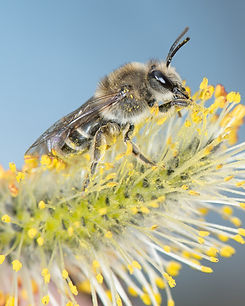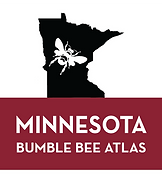
All About Bees > Observing Bees
Observing Bees
Observing bees can be an interesting and educational experience. Even though Minnesota hosts over five hundred bee species, locating bees can sometimes be difficult. Here are a few tips to increase your odds of finding them:
Slow Down
We live in a fast-paced world. To observe bees, you need to shift gears and slow down when conducting your search. Walk at a slow pace. Train your eyes to focus on the small things. In a patch of flowers, focus on a single flower. What do you see? Be prepared to be surprised.
Look for patterns in a bee's choice of flowers, their movement between flowers, and different ways they interact with a flower. Understanding some of these behaviors can help provide clues, so you can anticipate their next move. Standing in one place, quietly waiting for bees to move into your field of view is another way to observe or photograph bees.
Look for the Tiny Bees
After spotting larges bee interacting with a flower, retrain your eye to look for smaller insects. Some of Minnesota’s bee species are less than ¼ inch in length and often remain unseen. Are there other insects on the flower? Are there interactions between bees and other insects? If so, what do you think may be the cause of that interaction?
Use Your Senses
Bees navigate the natural world using their various senses—sight, smell, taste, and touch including perceiving the potential of electrical fields between them and flowers. While searching for bees, employ your senses. Besides using your eyes to look for bees, use your nose to find fragrant plants in bloom and listen closely for the buzz of bees as they approach flowers. With time, you may be able to discern the low buzz of a bumble bee from the higher pitched buzz of a small solitary bee.
Don't Forget to Look Up in Spring!
While it is common to associate observing bees on large patches of flowering perennials, much of the bee activity in spring may be happening in trees or large shrubs above your head. A minority of trees and almost all flowering shrubs rely on pollination by insects. For bees, some important trees and shrubs that bloom in early spring include red maple (Acer rubrum) and native willows (Salix spp.).
Note the Weather and Time of Day
Bees are selective about when they elect to leave their nest or visit flowers, and these decisions are usually influenced by weather conditions. If temperatures are too low, winds too high, or rain too intense, they tend not to fly. While you might encounter bees in poor weather, you are more likely to succeed if you search during favorable conditions—sunny, warm days. Look for bees when temperatures are above 70°F.
In addition to favorable weather conditions, bee activity can coincide with a particular flower development phase or the timing of floral resources (pollen or nectar) production. For example, a nectarless flower offering just pollen may only be open for one day. Pollen foraging by bees (and other insects) can deplete all the pollen offered by a newly opened flower by late morning. Searching for bees on these flowers in the afternoon would yield no returns.
In early spring on cool days below 70°F, you're more likely to observe bees in warm microhabitats (and not necessarily at flowers) such as close to the ground or on the sunny or south-facing side of objects like evergreen plants, walls, or large rocks.


Photographing Bees
Photographing bees is challenging but rewarding when you capture their beauty and can record your observations. Consider becoming a participatory scientist; share your photographs and observations with the research community. Your observations will become a permanent record and contribute to the scientific community’s knowledge of native bees.
Be Patient
Photographing bees can be challenging! Trying to capture a photo of these tiny and fast-moving objects can be frustrating. Patience and observation pays off, however.
No Sudden Movements!
It is easy to get excited when spotting an unusual bee but remember that sudden movements or rushing up to the bee will likely scare it off a flower. Practice moving slowly and fluidly toward the subject matter. Be aware of where the sun is and avoid casting a shadow on the subject.
Just Starting Out?
Set the Camera to "Auto"
If you are new to photography and using a digital camera, consider using the “intelligent auto” function if available. This will allow the camera to automatically adjust its settings as appropriate. Moreover, it enables you to maintain your distance while positioning the camera close to the bee(s) being photographed. Keeping your distance reduces the chance of disturbing bees. Close up photos allow you to crop them and still maintain a sharp image.
Note Where the Sun Is
Be aware of lighting. Taking photos toward sunlight or having the subject matter backlit is difficult. Photograph with the sun behind you but avoid casting a shadow on the subject. The more light and brightness, the clearer your photograph will be.
Get Familiar With the Camera Settings and Capabilities
Whether using a cell phone’s camera function or a digital camera, get to know its capabilities. Practice by taking closeup photos to learn how close your device can be to a subject and still capture sharp images.
Use the Macro Setting
Using your device’s macro setting allows you to get closer to the subject matter. Also, a number of clip-on macro lenses are available for cell phones. These can open up a whole new world of exploring the intracacies of tiny subjects such as bees.
Use the Flash
This may seem counterintuitive, but using the flash helps increase the depth of field of the subject and stops movement. When photographing bees in shadier sites, a flash is often essential to get a clear photograph.
Take Multiple Photos
Attempt to obtain photos showing the side, top, head, and face of the bee in order to aid in its identification on participatory science platforms such as iNaturalist. Take more than one photo before the bee flies away to ensure as many photos as possible are in focus. Tilt the camera so its lens/face is parallel to the plane of the subject matter.

Places to Observe Bees
We are fortunate to have many city, county, and state parks, and other public lands throughout Minnesota. Each offers its own unique opportunities to explore Minnesota’s diverse bee populations. Many public lands (including National Wildlife Refuges and Minnesota’s Scientific and Natural Areas) have no admission fees. However, it is not necessary to travel to see bees. Planting native flowers in a garden or walking to your local park provides opportunities to observe bees in your neighborhood.
Gardens
Any garden—a home garden or one on public property hosting a variety of native flowering plants—will attract bees. Many municipalities have gardens around buildings and facilities in addition to within parks.
Parks
Municipal, township, county, regional, state, and national parks offer opportunities to observe bees. Look for spaces within these parks that have garden plantings or open sunny natural habitat hosting a diversity of flowering plants.
Nature Preserves
Nature preserves typically are lands set aside to host rare plant communities and animals. Most are owned by local or county governments, but some nonprofit organizations such as The Nature Conservancy has nature preserves that are open to the public for passive use. Prior to visiting these preserves, refer to their online visitation guidelines and confirm that the site is open to the public.
School Campuses
College and university campuses often have dedicated staff and resources that focus on maintaining plantings throughout the campus property and around buildings. For example, the University of Minnesota St. Paul campus has a dedicated pollinator garden as well as plantings around the Bee Lab building. Other community college and state universities have formal gardens, natural areas including prairies, and arboretums.
Arboretums
Arboretums showcase collections of plants to the public and often include extensive gardens and plantings geared for bees and other pollinators.
Scientific and Natural Areas (SNAs)
SNAs are special sites that host rare plants, animals, and natural features managed by the Minnesota Department of Natural Resources. They are open to the public and allow for passive recreational activities that don't disturb the natural conditions of the site. When visiting an SNA to observe or photograph bees, refer to the posted guidelines and rules and practice a leave no trace ethic.
National Wildlife Refuges (NWRs)
There are thirteen national wildlife refuges in Minnesota. These sites are managed to conserve plants and animals, and their associated habitats. Most national wildlife refuges have free entry and offer unique opportunities to see various habitats and plant communities that support bees.
Wildlife Management Areas (WMAs)
Wildlife management areas (WMAs) are managed by the Minnesota Department of Natural Resources. These sites offer various types of wildlife habitat and are open to the public for recreation and hunting. There are about 1,500 WMAs in Minnesota. Refer to the posted guidelines and rules when visiting a WMA. Also, prior to visiting, check the DNR website for any pertinent information regarding hunting season(s).
Museums
Museums such as the Bell Museum of Natural History or Science Museum of Minnesota have native plant gardens providing opportunities to observe pollinators.

Participatory Science
Consider becoming a participatory scientist, share your photographs and observations with researchers. Your observations will become a permanent record and contribute to the scientific community’s knowledge of native bees. To learn more about how you can participate, explore the opportunities below:

Looking for a bee ID?
To get help with bee identifications, create a free iNaturalist or BugGuide account then upload your bee photo(s) to one of these sites. Experts will help you identify your bee. Once your bee is identified, visit this site to learn more about its natural history, nesting preferences, and conservation.
Explore Bee Families

Apidae
15 genera, 133 species
Bumble bees Bombus
Longhorn bees
Epimelissodes, Eucera, Melissodes
Carpenter bees
Ceratina, Xylocopa
Honey bees Apis
Digger bees Anthophora
Cuckoo bees Brachymelecta, Epeolus, Holcopasites, Nomada, Neolarra, Triepeolus
Squash bees Xenoglossa

2 genera, 39 species
Halictidae
10 genera, 133 species
Metallic green sweat bees
Agapostemon, Augochlora, Augochlorella, Augochloropsis
Large sweat bees
Dieunomia, Nomia
Short-faced bees Dufourea
Sweat bees Halictus
Small sweat bees Lasioglossum
Cuckoo (blood) bees Sphecodes
Megachilidae
14 genera, 86 species
Resin and pebble bees Anthidiellum, Dianthidium, Heriades, Paranthidium
Carder bees Anthidium, Pseudoanthidium
Mock orange bees Chelostoma
Mason bees Osmia, Hoplitis
Leafcutter bees Megachile
Sharp-tailed cuckoo bees Coelioxys
Dark cuckoo bees Stelis

Page Photography Credits
Heather Holm
Page Contributors
Don Leaon








